If you have any leftover meats such as BBQ pork or roast pork, this is a great way to eat it up!
INGREDIENTS:
1 package tofu (can be firm, median, soft...I prefer soft)
Whatever leftover cooked meats (sliced up) you have on hand.
1/4 C water
1 tbsp oyster sauce
1 tsp cornstarch diluted with 2 tsp cold water
1/4 tsp sesame oil
DIRECTIONS:
1. Cut tofu into small pieces.
2.Heat 1 tsb oil in the wok.
3. Add tofu and brown a little.
4. Add 1/4C of water, add oyster sauce and sesame oil and cover lid until water boils. Then, add the cooked meat and green onion.
5. Stir in the diluted cornstarch and heat until the sauce thickens. Serve hot.
INGREDIENTS:
-1 or 2 slabs of spareribs (depends on how many hungry mouths you'll be feeding)
-1 tsp of salt
-1 tsp of soy sauce
-2 tsp minced garlic
-2 tsp Korean meat sauce (Bulgigi sauce)
-2 tsp of sugar
DIRECTIONS:
1. Rinse whole slab of sparerib meat under cool water and pat dry. Place in dish.
2. Add all marinating ingredients and rub into meat. Cover dish with plastic wrap and place in fridge overnight.
3. Roast as a whole slab for 20 minutes at 350 degrees. Then flip to the other side and roast for another 8 minutes or so. Brush honey over the top and let carmelize another 2 minutes. Flip back to original side and brush with more honey. Turn off heat and let the spareribs carmelize a bit more in the remaining heat.
4. When cool to touch, carve and serve.
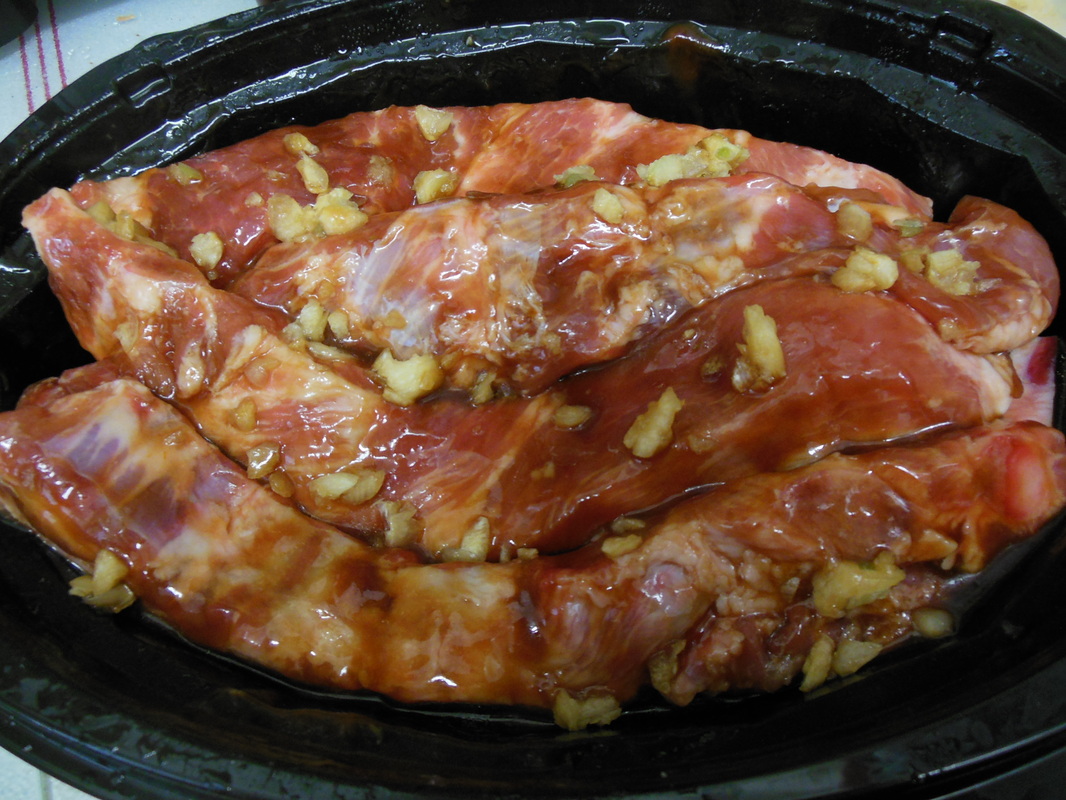
Marinated spareribs.
Unfortunately, I didn't have the camera the day we enjoyed the ribs. But it was flavourful, tender and I just love the slightly burnt, carmelized tips of the ribs.
Bamboo Girl #3 has just moved home and mom is cooking up a storm. There's pork belly marinating in the fridge and in a couple of days, it'll be ready for roasting. I'm looking forward to delightful CRUNCH of the pork skin!
BBQ pork, Roast pork, Roast duck, Soy sauce chicken are familiar sights in Chinese restaurants and in larger supermarkets. There are also numerous BBQ speciality shops as well and while all the gleaming roasted meats and birds on display may turn some away, the delicious aroma will definitely draw most people in.
While we usually buy our BBQ meat, mom sometimes get into a cooking mood and this is one of those times! INGREDIENTS:
-1 slab of pork belly (or two if you're hungry)
-5 spice, salt, sugar, soy sauce
DIRECTIONS:
1. Scrub the pork belly clean and pat dry with paper towel.
2. Rub a bit of soy sauce over the meat side of the pork belly. Then repeat witha mixture of 5-spice, salt and sugar. Leave the skin free of spice or soy sauce.
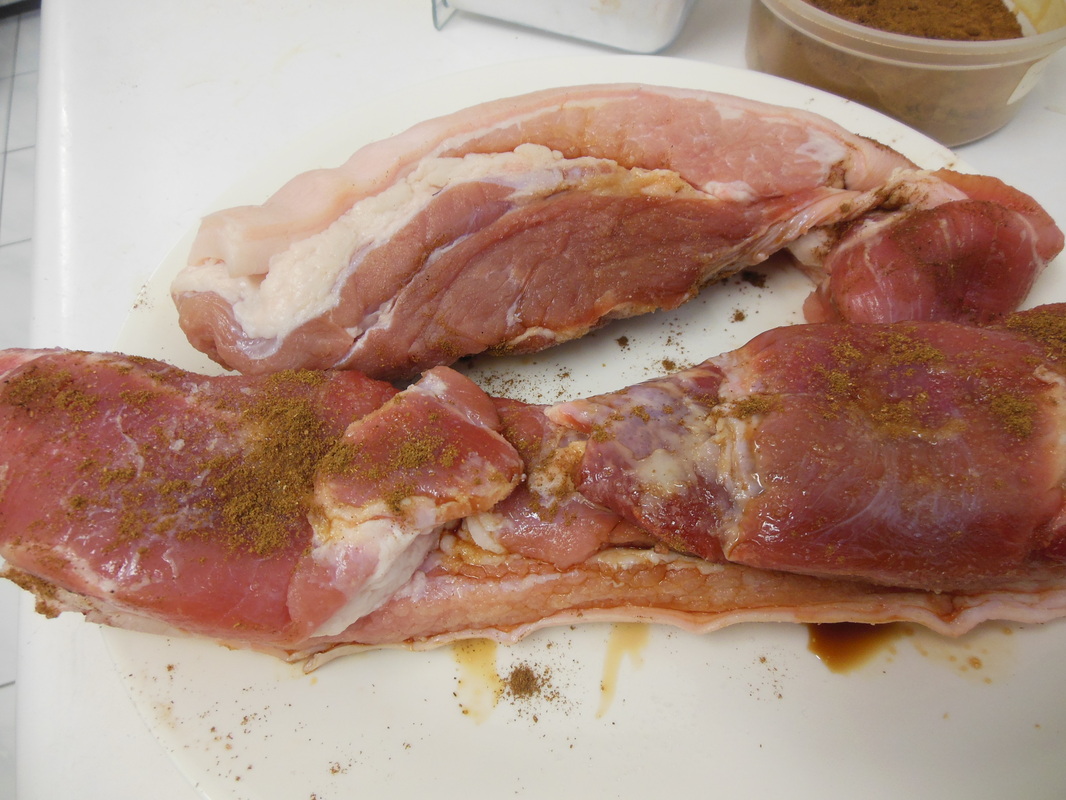
Rub a little soy sauce over the meat side of the pork belly. Then do the same with the spices.
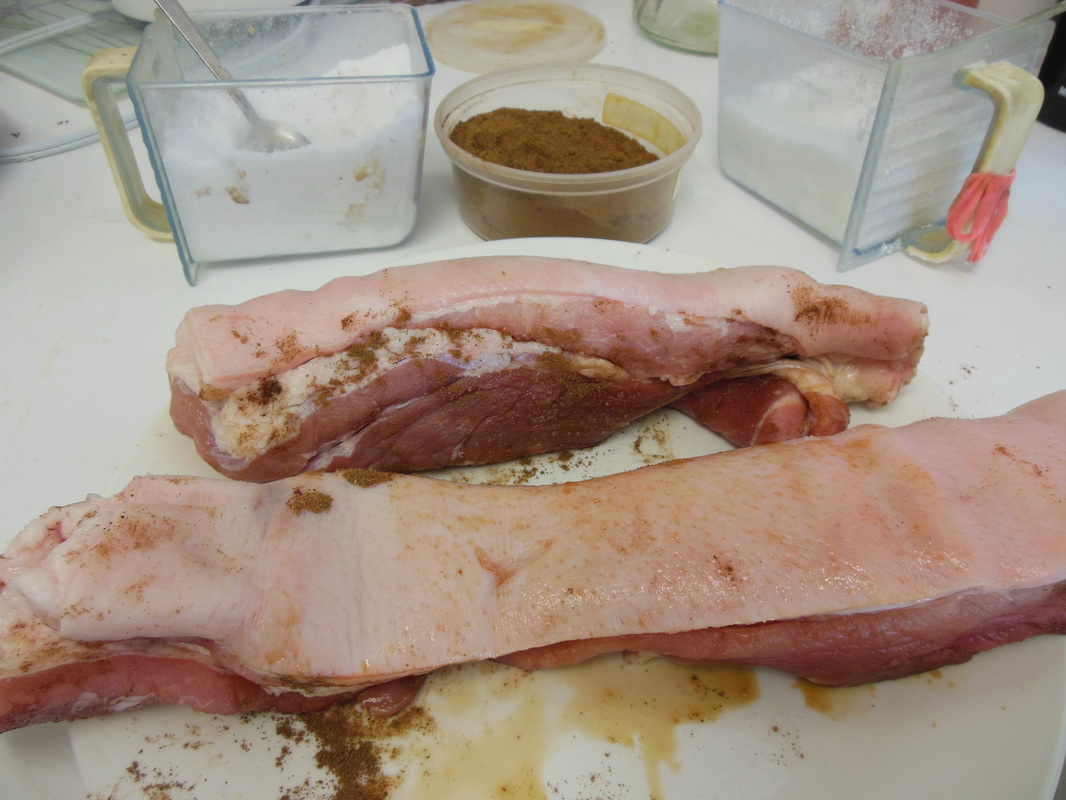
Ensure the skin is clean and dry so when roasted, it will extra crunchy!
3. Marinate in fridge uncovered for two days. You want the skin to dry out so that it will be crunchy and crispy when roasted.
4. When the pork skin is hard and dry to the touch, it is ready for roasting. Preheat oven to 350 degrees. Set pork belly skin-side down on a roasting rack...Do not let it sit in it's own juice or else the skin will not crackle.

After two days, the pork belly is dry enough for roasting.

Set skin side down on rack.
5. Roast for 30 - 40 minutes depending on thickness of cut. Meat can burn easily so do check every 15-20 minutes.
6. Flip over so it is skin-side up and broil for 10 minutes. Again, check regularly to prevent burning. The pork skin will turn to crackle.
7. Remove from heat and using a knife and fork, make a cut to check if meat is cut through. If not, flip pork belly onto side and roast for another 5-10 minutes. Do not put skin-side down anymore to ensure the skin crackle does not spoil.
8. Remove from heat and let cool completely before cutting and serving with mustard or Hoisin sweet sauce.
Juicy, moist chicken accompanied with minced ginger-spring onion dipping sauce...You know you're in a Chinese restaurant when you see this dish. But Chef Mom makes this dish regularly, especially when chicken is on sale.
Asians served their chicken dish and fish dish 'whole' meaning with head and tail. Why? I often wondered too as a kid. Eating fish or chicken fillet is so much easier and less messy. But I'm told that it's the restaurant's way to show their customers that they get everything they're paying for...No waiters/servers with sticky fingers stealing a piece or two. Also, the Chinese believe in good beginnings and endings...Thus, you get the head and the tail when ordering these dishes.
The reason I'm telling you this is because the photos I'm posting are slightly 'graphic' and not necessarily the most, well, appetizing. But trust me, the taste is great.
INGREDIENTS:
1. one 3lbs chicken with gizzards, kidneys, heart removed. (For bigger chickens, steam longer)
2. sliced ginger and spring onion, salt
Dipping Sauce:
-minced ginger, spring onion/scallions, salt, cooked oi;
DIRECTIONS:
1. Clear the cavity of the chicken. Give the chicken a good rinse. Rub salt all over the chicken and marinate overnight.
2. Place chicken in a steaming dish. Place some sliced ginger and spring onion on top and inside of the chicken.
3. Once the water in the pot has boiled, place the chicken on the steaming dish inside. Cover with lid and steam for 10-15min. Reduce to medium heat and continue steaming for another 30mins. Finally, turn off heat and keep chicken covered in pot for another 10-15mins. (Total cooking process is approx. 1 hour).
4. When cool to touch, cut chicken and serve with ginger/onion dipping sauce.
Dipping Sauce:
-In a small dish, add salt to minced ginger and spring onion. Heat a little oil in pan and once hot, spoon over the minced giner/spring onion. Mix well.
This posting is about organs, specifically duck kidneys so if you're squeamish about internal organs, you are warned!
Culture inspires me, religion invigorates me (as in a healthy, respectful debate) and languages interest me (admittedly, I have yet to master my own heritage language and the state of my French will leave my professeur in despair). And while religion and language are strong components of a culture, I would say nothing says culture more adepthly than food. It is also perhaps the easiest way to get introduced to a new culture. It's what I call a 3-D experience; you can smell it, taste it, feel it...And well, if it's alive before you gobble it, I suppose you can say you can hear it too?
Growing up in a Chinese family, I've had my fair share of what my non-Asian friends term as 'exotic' fare and I never fail to be amused by this. I suppose if you've been exposed to certain things from a young age, it doesn't strike you as unusual. And so, chicken feet, deep-fried sweet and sour intestines, braised kidneys, livers, stomach...I've had them and they're good! But, I am surprised that a few of my originally-from-Hong Kong friends are repulsed by this type of food. On the flip side, I do have a friend who eats pig brains and chicken testicles but I haven't worked up to that level yet.
Here are a few of the yummy dishes I mentioned above...Pics curtesy of Google. Mom says that about 30 years ago, wings ($0.25/lb), blue crabs ($0.25/lb), pork bones ($0.10/lb) and oxtails ($0.39/lb) were cheap! No one wanted chicken gizzards and were given away for free as with chicken feet from poultry farms. How silly, my mom thought of the non-Asians...All this good food and no one knows what to do with them. It's a different story now.
I am actually impressed that when an animal is slaughtered in an Asian market, generally, few parts are wasted...We're not going to get into sharks fin in this posting. That's a contentious one right now as Toronto considers a new ban on it. All I'm going to say is that while I'm a meat eater (I had a failed attempt at being a vegetarian), I don't believe in animal suffering and wastage. And now for my mom's duck kidneys. A family friend wanted to buy some dried duck kidneys for her watercress soup. At $28/lb, my mom said 'STOP'! She went to the supermarket at bought them fresh at $2.29/lb. Once dried, the 10lbs of fresh kidneys weighed in at 2.5lbs...And she spent only about $23.00! Moms are so economical! I wonder if they somehow magically become know-it-alls the minute they turn into a mom!
News of her dried duck kidneys travelled fast and for weeks after, we had racks and racks of drying duck kidneys. Below are two recipes, for dried duck kidneys and braised duck kideys in soy sauce.
Dried Duck Kidneys
INGREDIENTS:
-5lbs fresh duck kidneys yields approx. 1lb dried
-sea salt
-water
INSTRUCTIONS:
1. Rinse, clean and snip of fatty bits from kidneys. Put into bowl.
2. Pour sea salt over kidneys, mix well, set aside in friedge overnight.
3. Layer kidneys on drying rack and leave in sunny location for drying. At night, we put the trays near heat vents to speed up drying process.
(This would never work in Hong Kong; it's way to moist and it'll just get mouldy.)
4. Once dried, the kidneys take on a rich, deep burgundy hue. Pack in jar or plastic bag for future use.
TIP:
**Pick out small ones for braising as once dried, these become too small. See below for braising recipe.
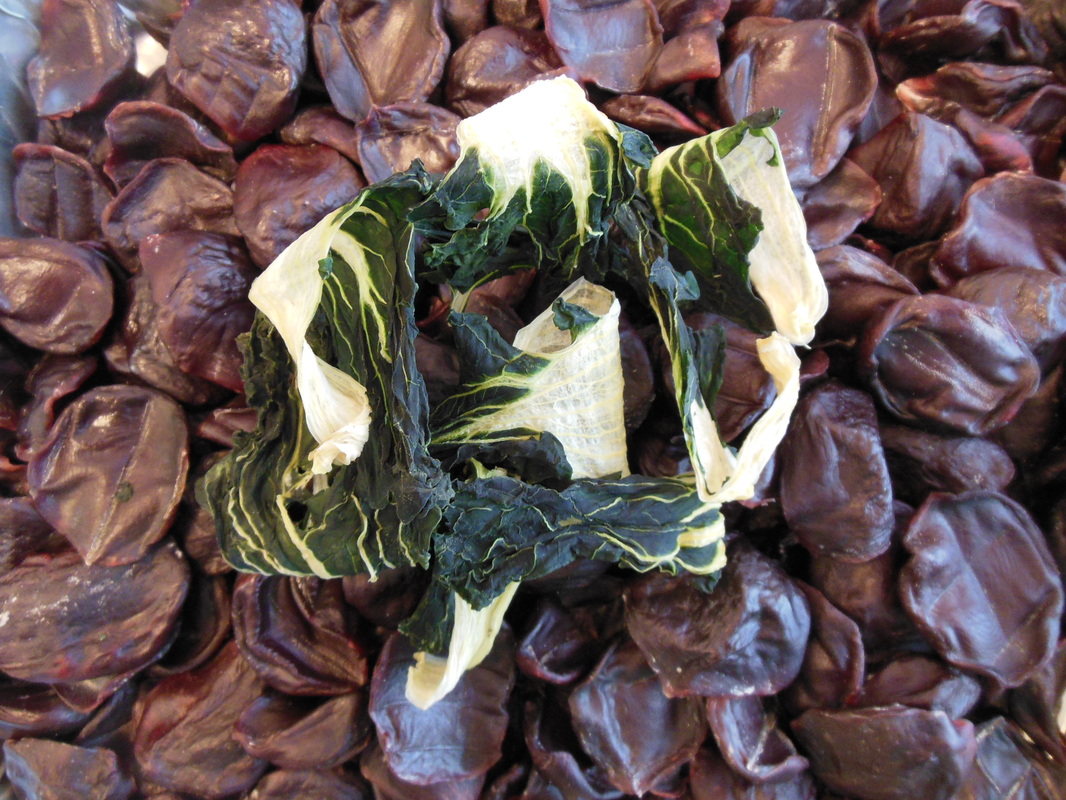 Ever the economical mom, she dries the older veggie leaves for making veggie soup. I included them here as a nice contrast to the dark red of the dried kidneys. Braised Duck Kidney in Soy Sauce:
Ingredients:
-duck kidneys
-Seasoning: soy sauce, rice wine, star anise, sliced ginger, sugar, sesame oil, a little water.
Instructions:
1. Rinse, clean and snip of fatty bits from duck kidneys. Drain and set aside.
2. Simmer in a pot, the seasoning ingredients. When it starts to bubble gently, lower temperature and add the kidneys.
3. Simmer for 15mins. Remove and garnish with scallions and/or coriander.
TIP:
**If there's a lot of seasoning sauce leftover, once cooled, pour into container and freeze for next use. You can use it to simmer pork tongue or hard-boiled eggs.
|







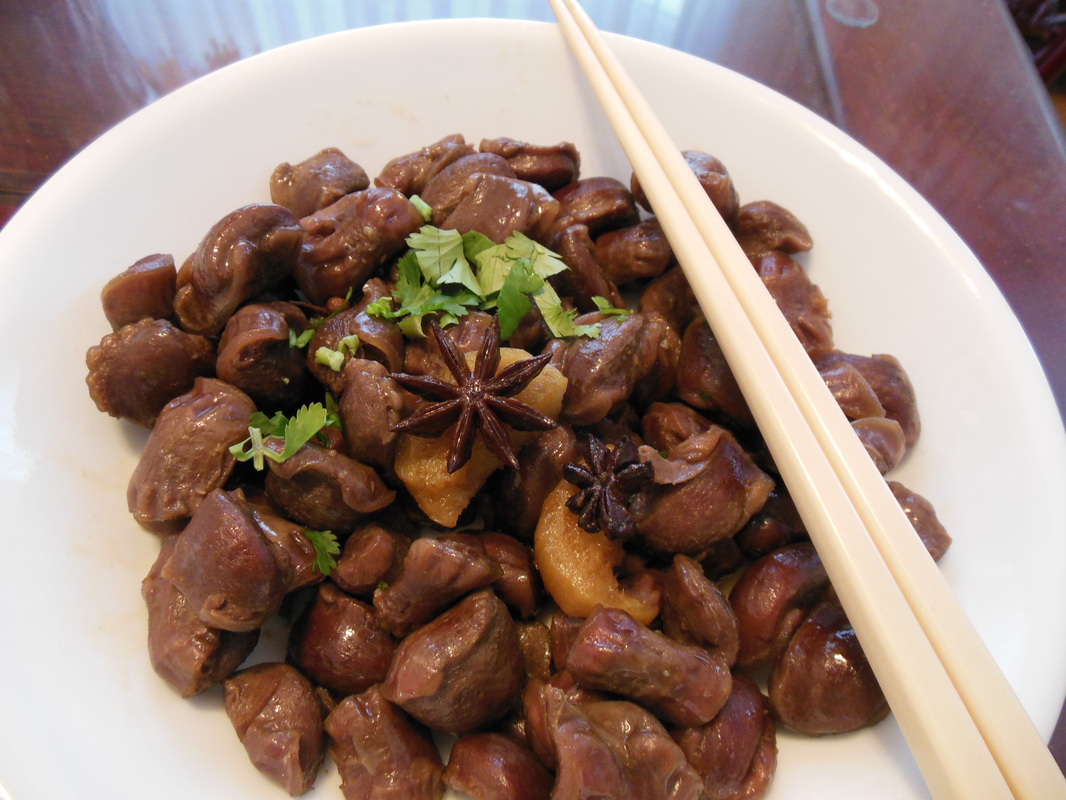
 RSS Feed
RSS Feed
